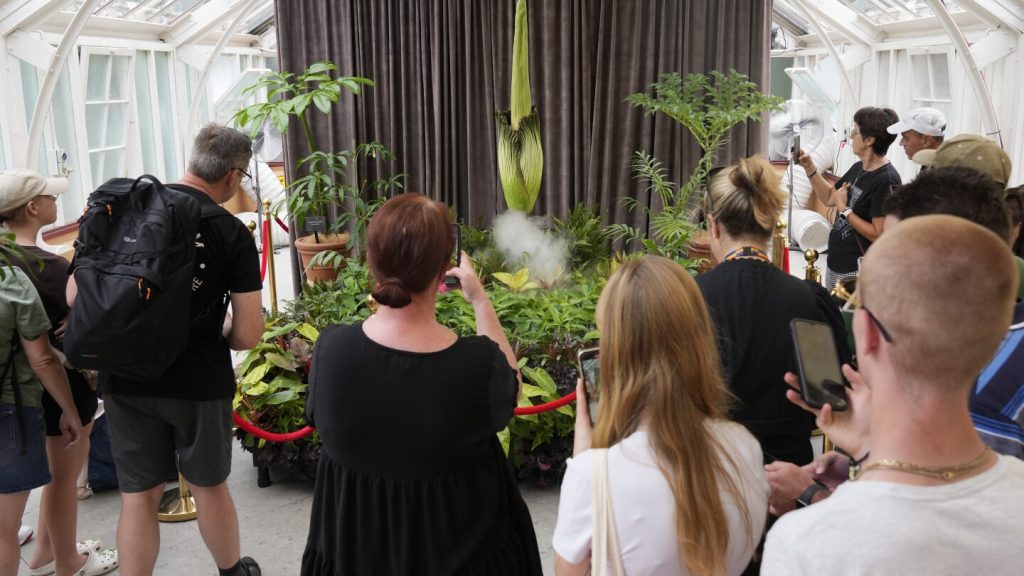The Rare Blossoming of the Corpse Flower in Australia
The corpse flower, known scientifically as Amorphophallus titanium, has captivated the world with its rare and extraordinary blooms. Recently, Australia witnessed a series of these unique flowerings, with three blooms occurring in as many months across different cities. This phenomenon has not only drawn massive crowds but also sparked curiosity about the science and significance behind these events.
What is the Corpse Flower?
The corpse flower, also referred to as the corpse plant or bunga bangkai in its native Indonesia, is a rare and striking plant species. Native to the rainforests of western Sumatra, it is known for its massive blooms and its distinctive, pungent odor, which mimics the smell of decaying flesh. This foul scent is a natural adaptation to attract pollinators like flies, which are drawn to the smell of rotting matter. In the wild, the corpse flower blooms only once every 7 to 10 years, and even then, the flower remains open for just a few days. With fewer than 300 plants believed to exist in their natural habitat and fewer than 1,000 globally (including those in cultivation), the corpse flower is a true rarity in the botanical world.
A Series of Blooms in Australia
In a highly unusual sequence of events, three corpse flowers have bloomed in Australia in quick succession. The first bloom occurred in November at the Geelong Botanic Gardens, southwest of Melbourne, attracting large crowds. In late January, another flower bloomed at the Sydney Royal Botanic Gardens, drawing around 20,000 admirers. Most recently, a corpse flower at the Australian National Botanic Gardens in Canberra bloomed for the first time in 15 years, opening on a Saturday and beginning to close by the following Monday.
Carol Dale, the acting nursery manager at Canberra’s botanic gardens, explained that the simultaneous blooming of these plants across different regions of Australia is not easily explained. She suggested that one theory could be that many of the plants are of a similar age, having accumulated enough energy in their underground tubers (called corms) to produce a bloom. However, Dale emphasized that the plants are grown under vastly different conditions in Canberra, Sydney, and Geelong, making the simultaneous blooming all the more surprising.
The Unexpected Bloom in Canberra
The bloom in Canberra was particularly unexpected. Dale had all but given up hope of the plant flowering there, given the city’s cooler climate, which occasionally experiences snowfall. “It’s been in our collection for slightly longer than these plants would normally take to flower for the first time,” Dale remarked, “so we just didn’t think we had the right conditions here in Canberra.” When the flower finally began to open around lunchtime on Saturday, staff and visitors alike were thrilled. By Saturday evening, the bloom’s infamous stench had intensified, becoming so potent that it could be smelled from across the road. Despite the overwhelming odor, which was likened to everything from dead animals and rotten eggs to sweaty socks and sewage, hundreds of people flocked to see the rare sight.
The greenhouse housing the flower implemented a ticketing system to manage the crowds, given the limited space. By Monday, the worst of the smell had subsided, though the plant still retained its signature rotting flesh aroma up close. Dale and her team took the opportunity to collect pollen from the flower, which could be used for research or to pollinate other corpse plants.
Public Fascination and the Environmental Connection
The corpse flower’s rare bloom has captivated the public imagination, drawing thousands of visitors to botanic gardens across Australia. While the plant’s infamous odor is undoubtedly a major draw, the spectacle also highlights the importance of conservation efforts for this endangered species. With fewer than 300 corpse flowers remaining in the wild, initiatives to protect and cultivate these plants are critical to ensuring their survival.
The recent blooms in Australia serve as a stark reminder of the beauty and fragility of nature. They also underscore the role that botanic gardens play in preserving rare and endangered species, offering a glimpse into the fascinating world of plants that might otherwise go unseen. For those fortunate enough to experience the corpse flower’s bloom, it is an unforgettable encounter—one that lingers in memory long after the smell has faded.
Conclusion
The series of corpse flower blooms in Australia is a remarkable and unexpected phenomenon that has captivated botanists and the public alike. While the exact reason for the simultaneous flowering remains unclear, it highlights the complexity and unpredictability of nature. For the hundreds who braved the pungent stench to witness these blooms, the experience was a rare privilege, offering a deeper appreciation for the unique characteristics of this extraordinary plant. As conservation efforts continue, the corpse flower remains a powerful symbol of the natural world’s beauty and resilience.












